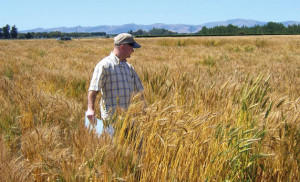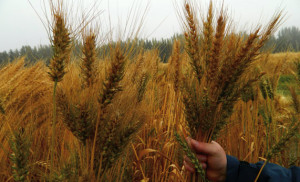Yearly trips to Arizona and New Zealand might make people think spring wheat breeder Karl Glover is the ultimate snowbird. But the associate professor of plant science is working. Honest.

Spring wheat breeder Karl Glover surveys a crop of South Dakota wheat growing in the Arizona desert. This produces enormous heads but not all of them reach maturity.
Glover travels half way around the world to develop his spring wheat varieties more quickly. He uses winter nurseries in New Zealand and Arizona to advance his breeding program.
Lincoln, New Zealand, is nearly as far south of the equator as Brookings is north, which makes it perfectly suited to growing South Dakota wheat, Glover explains. “The plants don’t know they’re not in South Dakota because during the New Zealand summer, the day and night periods are the same as in South Dakota.†In New Zealand, wheat is generally harvested in February.
Enormous yields in Yuma
Glover’s location near Yuma, Ariz., doesn’t work quite as well, but it’s less expensive. The seeds are sown in late October and harvested in April, Glover explains. The growing season is at least a month and a half longer than in South Dakota, but even after roughly five months, not all plants are completely mature because the day and night periods are not optimal.
However, it’s still worth it, Glover says, “because the amount of seed we typically get in return is incredible.†He estimated that 30 seeds can often produce a harvest of around two pounds of grain because the wheat produces more and larger heads.
The resulting crop is then shipped to Brookings, where the seeds are packaged for spring planting in South Dakota test plots. Eight doctoral students, one master’s student and four undergraduates currently work on Glover’s research projects.
White wheat for noodles, pastries

South Dakota wheat in Lincoln, New Zealand, grows as if it’s in the American Midwest because day and night periods are the same.
In 2006, the South Dakota Wheat Commission asked Glover to begin developing white spring wheat. Asians prefer white wheat flour for making noodles and pastries, explains cereal chemist Padu Krishnan (see related story on page 16). One half of the wheat that the U.S. exports is used to make products for the Asian market, Krishnan explains, so it’s important to consider what these consumers view as desirable qualities.
Two varieties of white winter wheat, Wendy and Alice, were released in 2004 and 2006; however, Glover estimated that white spring wheat may not be ready until 2015 or 2016. The Australians are the leaders in this area growing only white wheat.
Though millers have been asking for white wheat, marketing it creates problems for grain elevators, Glover explains. Segregating the white wheat from the red will be expensive, in terms of time and equipment. Before most producers will seriously consider planting white wheat, these hurdles must be overcome.
In order to capture a larger share of the world market, wheat producers will need to cater to the unique tastes of a growing Asian population.
Christie Delfanian






